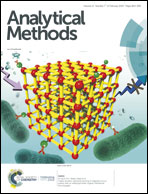An efficient “Ratiometric” fluorescent chemosensor for the selective detection of Hg2+ ions based on phosphonates: its live cell imaging and molecular keypad lock applications†
Abstract
Herein, we have reported the ability of smart chemosensors (L1 and L2) to selectively detect g2+ ions over other metal ions and examined this phenomenon by various spectroscopy techniques. Particularly, the proposed chemosensors exhibited notable color and spectra changes with the addition of mercury ions. Moreover, colorimetry measurements and fluorescence could be reversed with the addition of EDTA into the L1-Hg2+ and L2-Hg2+ solutions. Based on the excellent reversibility of this process, we designed a molecular-scale sequential information processing circuit and proposed the “Writing-Reading-Erasing-Reading” and “Multi-write” behaviors in the form of binary logic. Furthermore, L1 and L2 mimic a molecular keypad lock and molecular logic gates with the successive addition of Hg2+ and EDTA. The binding ability of Hg2+ ion with L1 and L2 was further demonstrated by density functional theory (DFT) studies. The biocompatibility of these chemosensors was successfully used for live cell imaging of Hg2+ in HeLa cells under the experimental conditions. Furthermore, the sensors L1 and L2 were useful in the determination of the concentration of Hg2+ ions in real water samples; this indicated their potential for practical applications.

- This article is part of the themed collection: Analytical Methods Recent HOT articles


 Please wait while we load your content...
Please wait while we load your content...